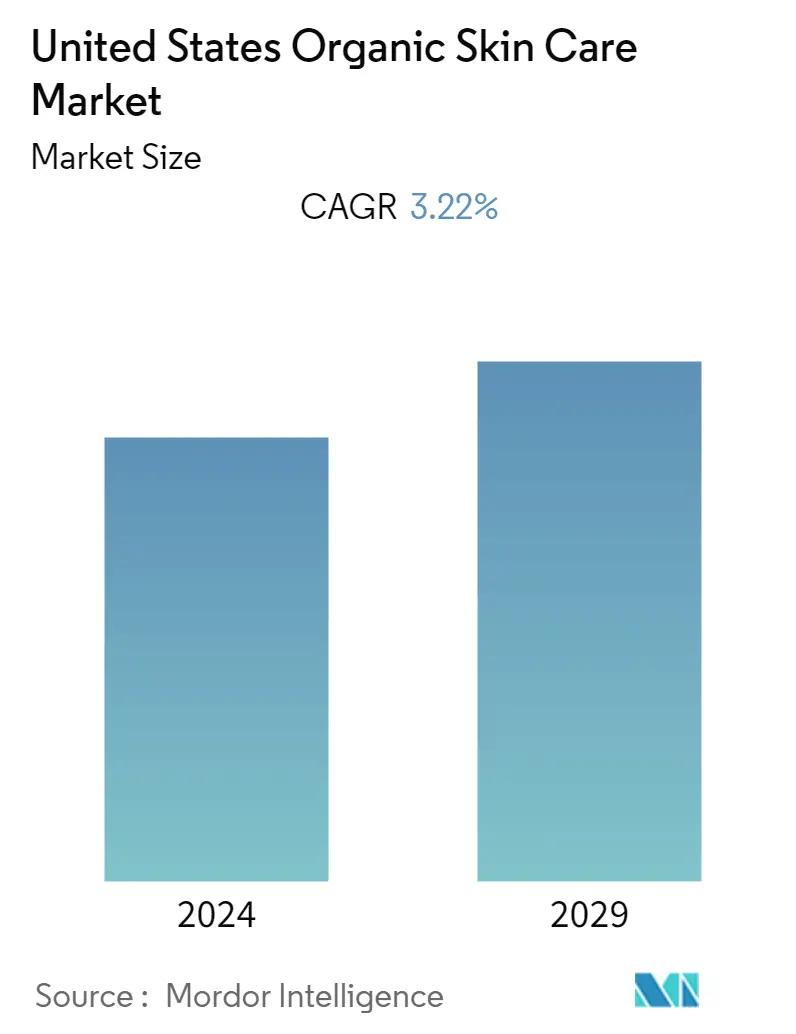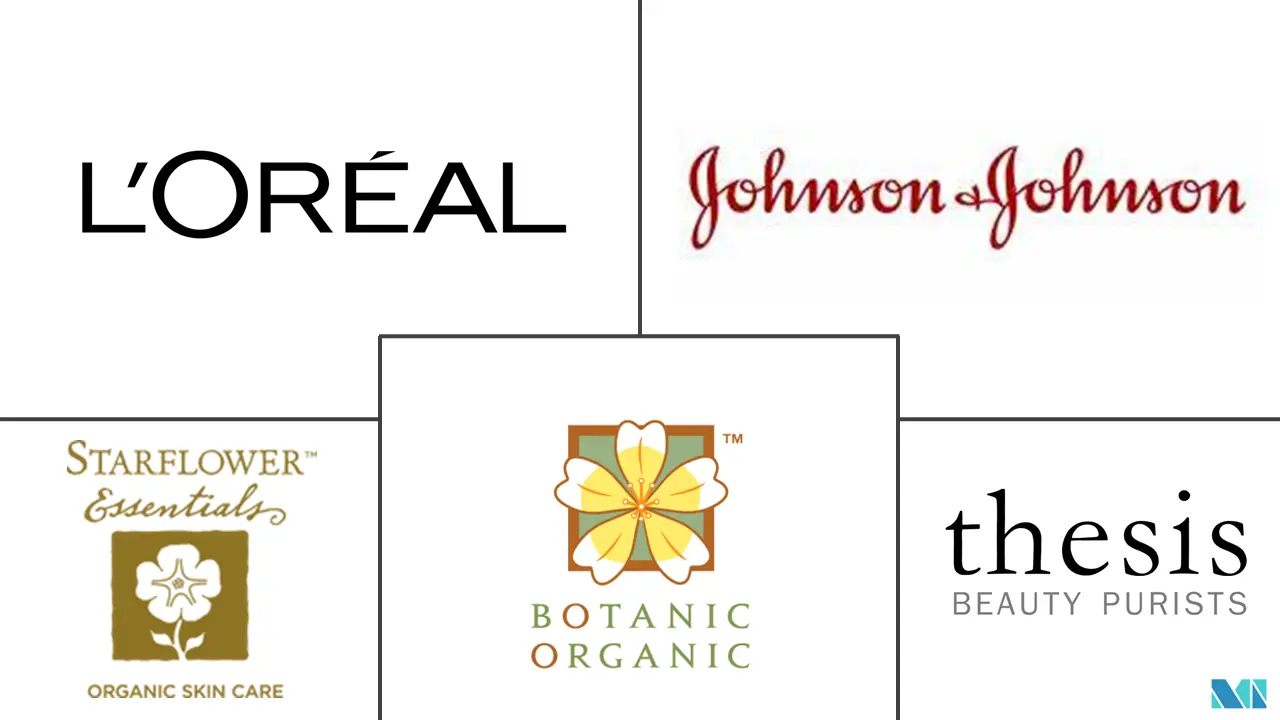Market Size of United States Organic Skin Care Industry

| Study Period | 2019 - 2029 |
| Base Year For Estimation | 2023 |
| Forecast Data Period | 2024 - 2029 |
| Historical Data Period | 2019 - 2022 |
| CAGR | 3.22 % |
| Market Concentration | Low |
Major Players
*Disclaimer: Major Players sorted in no particular order |
United States Organic Skincare Market Analysis
The United States organic skin care market is projected to grow at a CAGR of 3.22% over the next five years.
- With the increasing demand for organic ingredients and increasing awareness about the harmful effects of chemicals and synthetic products, consumers across the country are inclined toward organic personal care products, including skincare products. Some people have sensitive skin, and they cannot tolerate the constant use of synthetic skin care products on a daily basis. Increasing concerns regarding the adverse effects of chemicals on the skin, such as skin irritation, dryness, and dullness, have been the key factors fueling the market growth for organic skin care products in the United States.
- Furthermore, skin-related problems are increasing in the country due to environmental conditions, leading consumers to use skin care products like serums, moisturizers, and face creams daily. According to US Census Bureau data from 2021, the United States has about 50.3 million females population between the ages of 40-64. Because of this, demand for organic anti-aging creams is also increasing in the region.
- Additionally, the demand for face and sheet masks is gaining popularity among consumers as they are easy to use, disposable, and effective. Market players have been innovating facemasks with different ingredients and more hydrating power. For instance, in October 2022, SolaWave, a United States-based skincare brand, launched a new hydrating sheet mask. The mask is made from vegan sources and biodegradable paper that fits on your face perfectly. Due to an increase in pollution problems, a rise in disposable income, and industrialization, the market is expected to grow over the medium term.
United States Organic Skincare Industry Segmentation
Organic skin care products are made with ingredients that are grown without chemicals or pesticides. The United States organic skin care market is segmented by product type and distribution channel. Based on the product type, the market has been segmented into face care and body care products. Based on facial care, the market is segmented into cleansers, moisturizers and oils/serums, face masks and packs, and other facial care products. Based on body care, the market is segmented into body lotions, body wash, and other body care products. Based on distribution, the market is segmented into supermarkets/hypermarkets, specialty retail stores, online retail stores, and other distribution channels. For each segment, the market sizing and forecasts have been done based on value (in USD Million).
| Product Type | ||||||
| ||||||
|
| Distribution Channel | |
| Supermarkets/Hypermarkets | |
| Specialty Retail Stores | |
| Online Retail Stores | |
| Other Distribution Channels |
United States Organic Skin Care Market Size Summary
The United States organic skin care products market is experiencing a notable expansion, driven by a growing consumer preference for products containing organic ingredients. This shift is largely attributed to increasing awareness of the adverse effects associated with chemical and synthetic products, such as skin irritation and dullness. As consumers become more conscious of these issues, there is a rising demand for organic personal care products, including serums, moisturizers, and face creams. The market is further bolstered by the increasing prevalence of skin-related problems due to environmental factors, which has led to a surge in the use of organic anti-aging creams and other skincare solutions. The popularity of face and sheet masks is also on the rise, with innovations in hydrating and vegan-friendly options contributing to market growth.
The clean beauty movement is significantly influencing the organic skin care market, with consumers increasingly seeking products made from natural extracts and botanical ingredients. This trend has prompted both domestic and international manufacturers to invest in research and development, launching new organic beauty lines to meet consumer demand. The market is characterized by a competitive landscape, with major players like L'Oréal S.A., Johnson & Johnson, and Botanic Organic LLC leading the charge. These companies are expanding their product offerings to cater to various skin types and concerns, such as dry, sensitive, and acne-prone skin. The introduction of organic cleansers and face care products, along with a robust distribution network, is enabling manufacturers to capitalize on the growing demand for organic skin care solutions across the United States.
United States Organic Skin Care Market Size - Table of Contents
-
1. MARKET DYNAMICS
-
1.1 Market Drivers
-
1.2 Market Restraints
-
1.3 Porter's Five Forces Analysis
-
1.3.1 Threat of New Entrants
-
1.3.2 Bargaining Power of Buyers/Consumers
-
1.3.3 Bargaining Power of Suppliers
-
1.3.4 Threat of Substitute Products
-
1.3.5 Degree Of Competition
-
-
-
2. MARKET SEGMENTATION
-
2.1 Product Type
-
2.1.1 Facial Care
-
2.1.1.1 Cleansers (including Exfoliators/Facial Scrubs)
-
2.1.1.2 Moisturizers and Oils/Serums
-
2.1.1.3 Face Masks and Packs
-
2.1.1.4 Other Facial Care Products
-
-
2.1.2 Body Care
-
2.1.2.1 Body Lotions
-
2.1.2.2 Body Wash
-
2.1.2.3 Other Body Care Products
-
-
-
2.2 Distribution Channel
-
2.2.1 Supermarkets/Hypermarkets
-
2.2.2 Specialty Retail Stores
-
2.2.3 Online Retail Stores
-
2.2.4 Other Distribution Channels
-
-
United States Organic Skin Care Market Size FAQs
What is the current United States Organic Skin Care Market size?
The United States Organic Skin Care Market is projected to register a CAGR of 3.22% during the forecast period (2024-2029)
Who are the key players in United States Organic Skin Care Market?
L'Oréal SA, Johnson & Johnson (Neutrogena), Starflower Essentials Organic Skin Care, Thesis Beauty and Botanic Organic LLC are the major companies operating in the United States Organic Skin Care Market.

